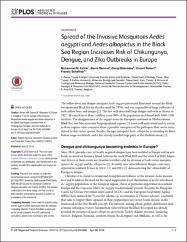| dc.contributor.author | Akıner, Muhammet Mustafa | |
| dc.contributor.author | Demirci, Berna | |
| dc.contributor.author | Babuadze, Giorgi | |
| dc.contributor.author | Robert, Vincent | |
| dc.contributor.author | Schaffner, Francis | |
| dc.date.accessioned | 2020-12-19T19:55:34Z | |
| dc.date.available | 2020-12-19T19:55:34Z | |
| dc.date.issued | 2016 | |
| dc.identifier.citation | Akiner, M.M., Demirci, B., Babuadze, G., Robert, V., Schaffnr, F. (2016). Spread of the invasive mosquitoes aedes aegypti and aedes albopictus in the Black Sea Region increases risk of Chikungunya, Dengue, and Zika Outbreaks in Europe. Plos Neglected Tropical Diseases, 10(4). https://doi.org/10.1371/journal.pntd.0004664 | |
| dc.identifier.issn | 1935-2735 | |
| dc.identifier.uri | https://doi.org/10.1371/journal.pntd.0004664 | |
| dc.identifier.uri | https://hdl.handle.net/11436/2550 | |
| dc.description | Schaffner, Francis/0000-0001-9166-7617; ROBERT, Vincent/0000-0003-1738-1842 | en_US |
| dc.description | WOS: 000375376700076 | en_US |
| dc.description | PubMed: 27115737 | en_US |
| dc.description.abstract | The yellow fever and dengue mosquito Aedes aegypti previously flourished around the Mediterranean and Black Sea for decades until the 1950s, and was responsible of large outbreaks of
both yellow fever and dengue [1]. The first well-described large dengue outbreak in Greece in
1927–28 caused more than 1 million cases (90% of the population in Athens) with 1000–1500
fatalities. The disappearance of Ae. aegypti from the European continent in Mediterranean,
Black Sea, and Macaronesian biogeographical regions [2] is not well understood and its return
in these regions raises concerns about a possible resurgence of the pathogens that can be transmitted by this vector species. Besides, the tiger mosquito Aedes albopictus is extending its distribution range worldwide, and it has already invaded large parts of the Mediterranean [1]. | en_US |
| dc.description.sponsorship | European Food Safety Authority (EFSA) [OC/EFSA/AHAW/2013/02-FWC1]; European Centre for Disease prevention and Control (ECDC) | en_US |
| dc.description.sponsorship | This work was carried out under the VectorNet framework contract OC/EFSA/AHAW/2013/02-FWC1 funded by the European Food Safety Authority (EFSA) and the European Centre for Disease prevention and Control (ECDC). the funders contributed to the study design, but had no role in data collection and analysis, decision to publish, or preparation of the manuscript. | en_US |
| dc.language.iso | eng | en_US |
| dc.publisher | Public Library Science | en_US |
| dc.rights | info:eu-repo/semantics/openAccess | en_US |
| dc.title | Spread of the invasive mosquitoes aedes aegypti and aedes albopictus in the Black Sea Region increases risk of Chikungunya, Dengue, and Zika Outbreaks in Europe | en_US |
| dc.type | article | en_US |
| dc.contributor.department | RTEÜ, Fen - Edebiyat Fakültesi, Biyoloji Bölümü | en_US |
| dc.contributor.institutionauthor | Akıner, Muhammet Mustafa | |
| dc.identifier.doi | 10.1371/journal.pntd.0004664 | |
| dc.identifier.volume | 10 | en_US |
| dc.identifier.issue | 4 | en_US |
| dc.ri.edit | oa | en_US |
| dc.relation.journal | Plos Neglected Tropical Diseases | en_US |
| dc.relation.publicationcategory | Makale - Uluslararası Hakemli Dergi - Kurum Öğretim Elemanı | en_US |


















